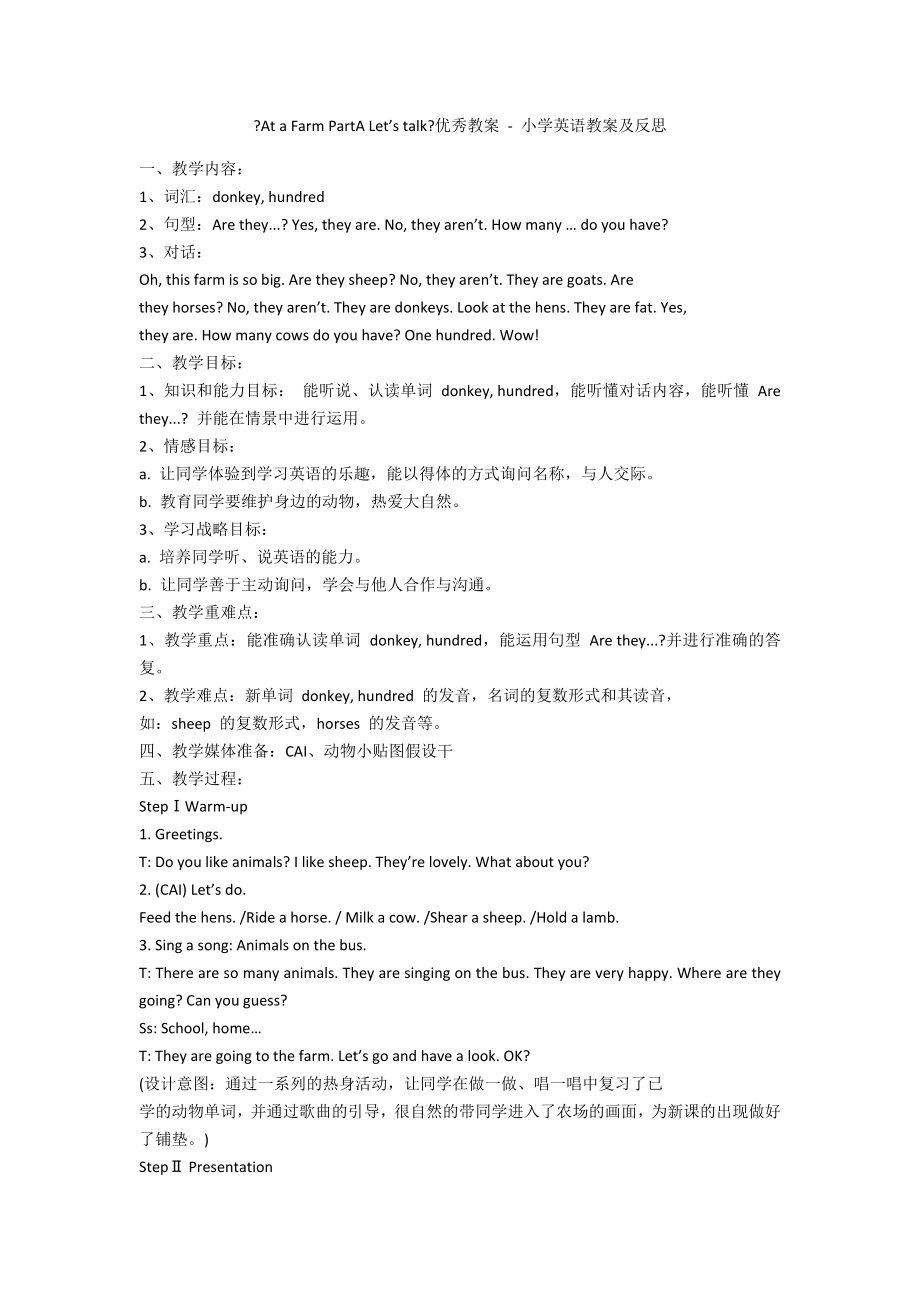《《At a Farm PartA Let’s talk》優(yōu)秀教案 - 小學(xué)英語教案及反思》由會員分享�����,可在線閱讀�����,更多相關(guān)《《At a Farm PartA Let’s talk》優(yōu)秀教案 - 小學(xué)英語教案及反思(3頁珍藏版)》請在裝配圖網(wǎng)上搜索�����。
1、?At a Farm PartA Let’s talk?優(yōu)秀教案 - 小學(xué)英語教案及反思
一�����、教學(xué)內(nèi)容:
1���、詞匯:donkey, hundred
2�、句型:Are they...? Yes, they are. No, they aren’t. How many … do you have?
3����、對話:
Oh, this farm is so big. Are they sheep? No, they aren’t. They are goats. Are
they horses? No, they aren’t. They are donkeys. Look at th
2、e hens. They are fat. Yes,
they are. How many cows do you have? One hundred. Wow!
二��、教學(xué)目標(biāo):
1���、知識和能力目標(biāo): 能聽說����、認(rèn)讀單詞 donkey, hundred�����,能聽懂對話內(nèi)容�����,能聽懂 Are they...? 并能在情景中進(jìn)行運用�。
2、情感目標(biāo):
a. 讓同學(xué)體驗到學(xué)習(xí)英語的樂趣��,能以得體的方式詢問名稱���,與人交際����。
b. 教育同學(xué)要維護(hù)身邊的動物�,熱愛大自然。
3����、學(xué)習(xí)戰(zhàn)略目標(biāo):
a. 培養(yǎng)同學(xué)聽、說英語的能力��。
b. 讓同學(xué)善于主動詢問�,學(xué)會與他人合作與溝通。
三���、教學(xué)重難點:
3��、
1����、教學(xué)重點:能準(zhǔn)確認(rèn)讀單詞 donkey, hundred,能運用句型 Are they...?并進(jìn)行準(zhǔn)確的答復(fù)��。
2����、教學(xué)難點:新單詞 donkey, hundred 的發(fā)音,名詞的復(fù)數(shù)形式和其讀音�,
如:sheep 的復(fù)數(shù)形式,horses 的發(fā)音等����。
四、教學(xué)媒體準(zhǔn)備:CAI����、動物小貼圖假設(shè)干
五、教學(xué)過程:
StepⅠWarm-up
1. Greetings.
T: Do you like animals? I like sheep. They’re lovely. What about you?
2. (CAI) Let’s do.
Feed the hens.
4��、 /Ride a horse. / Milk a cow. /Shear a sheep. /Hold a lamb.
3. Sing a song: Animals on the bus.
T: There are so many animals. They are singing on the bus. They are very happy. Where are they going? Can you guess?
Ss: School, home…
T: They are going to the farm. Let’s go and have a look. OK?
(設(shè)計
5���、意圖:通過一系列的熱身活動�����,讓同學(xué)在做一做����、唱一唱中復(fù)習(xí)了已
學(xué)的動物單詞��,并通過歌曲的引導(dǎo)�,很自然的帶同學(xué)進(jìn)入了農(nóng)場的畫面,為新課的出現(xiàn)做好了鋪墊�����。)
StepⅡ Presentation
1. T: Look! This farm is so big. We’ll have a competition this class. Let’s see which group can get more animal stickers, OK? This farm is for Group A, and this farm is for Group B. Come on!
2. Play a
6���、 guessing game.
(CAI:出示因為距離遠(yuǎn)而看不清楚的動物)T: Oh, sorry. We can’t see it clearly. Can you guess?
T: What’s this? Ss: This is a tiger.
T: What are they? Are they cows? Ss: (引導(dǎo)同學(xué)答復(fù)) Yes, they are.
T: Are they hens? Ss: Yes, they are.
T: Are they horses? Ss: (引導(dǎo)同學(xué)答復(fù)) No, they aren’t.
T: They are donkey
7�、s. Ss repeat.
(設(shè)計意圖:通過出示遠(yuǎn)處動物的圖片����,引導(dǎo)同學(xué)仔細(xì)觀察并學(xué)會用Yes, they are./ No, they aren’t. 答復(fù)下列問題,且引出新單詞donkeys。該游戲不只能吸引同學(xué)的注意力���,也為同學(xué)創(chuàng)設(shè)了一個真實的語境�����。)
3. T:There are so many animals at the farm. Do you like them? Why?
Ss: I like the monkeys. They are funny. I like the hens. They are fat….
4. (CAI: 播放同學(xué)熟悉的動物的叫聲�����。)T: A
8�����、nimals are our friends. Listen! They are coming, too.
T: Can you guess? What are they?
Ss: Are they …?
T: Yes, they are./ No, they aren’t.
(設(shè)計意圖:通過聽聲音猜熟悉的動物名稱�����,不只能讓同學(xué)在真實的情景中運用Are they …?提問�����,而且復(fù)習(xí)了一些學(xué)過的動物單詞�����,有效激發(fā)了同學(xué)的學(xué)習(xí)興趣�����。)
StepⅢ Practice
1. Let’s make a chant.
a. (CAI: 出示教師自編的詩歌�����。) T: Let’s chant.
9�、
Sheep, sheep, are they sheep?
Yes, yes, yes, they are.
Horses, horses, are they horses?
No, no, no, they aren’t.
b. (CAI: 出示重點單詞和新授句型����。) T:Can you make a chant?
Have them practice in groups. Then act it out.
(設(shè)計意圖:同學(xué)在教師指導(dǎo)下自身創(chuàng)編詩歌,能有效提高同學(xué)自主學(xué)習(xí)的能力�,激發(fā)同學(xué)的創(chuàng)造力,培養(yǎng)了同學(xué)團(tuán)隊協(xié)作的能力��。)
2. Ask and answer.
a. (C
10��、AI: 播放Let’s talk.) T:Open the books, please. Listen and try to answer the questions. “Can you see the cows? How many cows can you see?〞
Ss: Yes. I can see one hundred.
b. (CAI: 第二次播放Let’s talk.) Listen again and answer.
T: What animals are there at the farm?
3. Listen and repeat the dialogue.
4
11����、. Role play.
(設(shè)計意圖:讓同學(xué)帶著問題聽錄音,能提高同學(xué)聽錄音的效率, 加深對對話的理解程度���。跟錄音朗讀有助于同學(xué)模仿地道的語音�����、語調(diào)�����,也能為同學(xué)說好英語打好根底�。)
Step IV Production
1. Draw a beautiful farm.
(Have them draw a farm in groups.) T: Let’s try to draw a beautiful farm. You must help each other. You only have three minutes. Let’s go.
2. Describe my farm.
12、
T: Oh, your farm is so nice. There are some visitors. Let’s describe our farm. OK?
(設(shè)計意圖:同學(xué)通過小組合作完成農(nóng)場設(shè)計�����,并互相交換欣賞農(nóng)場���,在真實的語境中靈活運用所學(xué)句型�����,表達(dá)了教學(xué)的開放性�,給同學(xué)提供了一個運用語言交流的時機(jī)��。)
3. (CAI) T: Animals are so lovely. When is World Animal Day? Do you know?
It’s October 4th. Animals are our friends. We love animals. S
13�、s say it together.
Step V Summary
1. Assessment.
T: Every one did a good job today. T:Look at your farm, what have you got? Are they cows /horses? Ss: Yes, they are. /No, they aren’t. Now, let’s see how many animals do you have?
〔設(shè)計意圖:教師從同學(xué)參與課堂活動的態(tài)度���、興趣、效果和合作能力等方面對同學(xué)進(jìn)行恰當(dāng)?shù)脑u價�����,十分有益于同學(xué)樹立自信心����,形成繼續(xù)學(xué)習(xí)的動力���?���!?
2. Homework: Talk about your farm to your parents.
T: Look! Time is up. It’s time to go home . Tell your parents what you see at the farm. Let’s say “Good bye!〞 to the farmer and the animals.
Blackboard Design:
Unit 6 At a Farm
Are they …?
Yes, they are.
No, they aren’t.
 《At a Farm PartA Let’s talk》優(yōu)秀教案 - 小學(xué)英語教案及反思
《At a Farm PartA Let’s talk》優(yōu)秀教案 - 小學(xué)英語教案及反思

